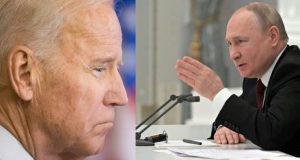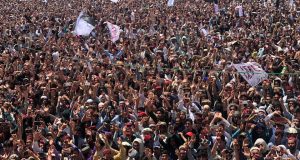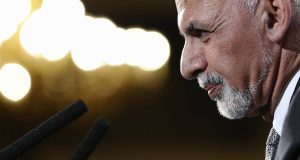PARACHINAR: (BY ANWAR ZEB) Maria Kumari lowers her head and touches the tip of her nose with her index finger, She lips moving silently in prayers. She is offering the Kamaya Karam – a religious prayer to get her wishes granted. Her whole family pray in the upper story of their house instead of a Mandar, or a temple for the Hindu community to worship.
“The temple is 25 kilometer away from our home,” says Kumari, a 27 year old university graduate, who lives in Kurram Agency in the tribal area along the Pakistan-Afghanistan border. “We have to pay a 1,000 to 1,200 Pakistani rupees for a single trip to the Mali Khel village where the Mandar is.”
The last time Kumari and her family did Puja – prayers – at the temple was in August last year when they had to hire a taxi to get there. She said in Kurrum Agency there were only three worships places for Hindu and Sikh minorities – in Ibrahim Zai village, in Mali Khel village and a single room temple in Upper Kurrum. She said these were not enough for the community and as a result many people performed their prayers and rituals at home.
“We often forego festivals like Holi, Devali and Raksaha Bandan because worship places in the tribal area are not accessible to all,” said Kumari.
A survey conducted by All Pakistan Hindu Rights Movement (APHRM) in 2014 says that 408 Hindu temples have been converted either to hotels or commercial buildings, or illegally occupied by the Evacuee Trust Property Board (ETPB). Among a dozen of these worship places are in the Federally Administered Tribal Areas (FATA). The survey report says presently there are only twenty temples functional in the entire country.
According to the APHRM report, a “minimum fifty thousand minority peoples” live in FATA. Among them, Hindus are in majority.
Chairman of All Pakistan Hindu Rights Movement, Haroon Srab Diyal, said religious minorities in FATA lacked worship places. Most of the Hindu and Sikh properties, including worship places, he said, had been occupied or leased out by ETPB for commercial purposes.
“ETPB has occupied our religious sites and properties on the name of protection,” said Diyal. “There is no Path Shala (school), no Dharam Shala (seminary), no Shamshan Ghat (a place where Hindu and Sikh people cremate the dead) or other religious sites except the odd Mander and Gurdwara (a Sikh temple). This is not just in FATA but in the entire Pakistan.”
He said: “Owing to the absence of religious places and clergy, Hinduism in FATA is fading out.”
He said that during wedding ceremonies, the Hindu community in FATA relied only on Mangal Phera (circumambulation around fire), foregoing all other pre and post marriage rituals in absence of a Pundit (a member of Hindu clergy) and Pujari (worshipers).
“Hindus in FATA didn’t have the opportunity to learn and practice Hinduism in FATA,” said Diyal. “Currently there is not a single family living in Khyber Agency because there is no temple in the entire agency for the Hindu minority. The situation in other tribal areas is more or less the same.”
FATA and Khyber Pakhtunkhwa (KP) were Hindu dominant regions before the Partition of British India in Pakistan and India, said Diyal. There were Hindu religious sites and property everywhere, he said, but now the government was reluctant to share the exact scale and numbers with them.
“According to Article 25 of the Constitution, we are equal citizens of Pakistan,” he said. “The government should give us our rights and properties back.”
The problem of ascertaining and claiming land and properties in FATA is serious because there is no land record. About the illegal occupation of Hindu properties in FATA and in KP province, Dr. Qibla Ayaz, Head of Higher Education Commission’s [Islamic] Seerat Chair at University of Peshawar, said the government should hand over all properties back to minorities or the revenue generating from their use should be spent on welfare and development of minorities.
He said like other constitutions before it, the 1973 Constitution of Pakistan allowed minorities living in Pakistan to practice their religious duties and rituals freely. He said it was the duty of EPTB to protect minority properties, not misuse it.
Ayaz said Islam recognized the fundamental right to life and honor of every individual irrespective of their religion, sect, beliefs, race, color and creed. “Diversity is the beauty of Pakistan and it should be protected at any cost,” he said.
Zahid Chand, a resident of Miranshah in North Waziristan Agency (NWA), also voiced concern over the lack of worship places in tribal areas.
He said on telephone that in Miranshah the population of Hindu minority was about 200 persons. “We don’t have any place for worship in the whole area at all,” he said. “So we perform all religious rituals at home.”
Chand said that after displacement and repatriation to NWA following the military operation Zarb-e-Azb against militants in the region, the political administration had decided to establish a community center where Hindu community could worship and pray. He said that many Hindu families had shifted to Khyber Pakhtunkhwa province and other parts of Pakistan due to absence of religious places in FATA.
Member of National Assembly for Minorities, Isphanyar Minocher Bhandara, had told media during a recent visit to Bhai Juga Singh Gurdwara in Peshawar that many holy places and worship sites belonging to minorities had been occupied by EPTB or other government departments.
He said the government was trying to reinstate and handover these properties to minorities as soon as possible. He said the government had released funds for welfare of minorities but the amount was not enough for the uplift of minority religious communities.
Despite repeated attempts, EPTB Chairman Siddique Alfarooq was not available for comments on the issue of minority worship places and properties in Pakistan.
The Pashtun Times
 Pashtun Times Latest News
Pashtun Times Latest News




